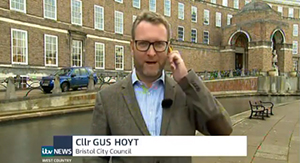BRISTOL BIGWIGS HAVE HISTORY FOR THIS SORT OF THING…
If our illustrious millionaire mayor George Ferguson and his idiot boy wonder Councillor Augustus Hoyt have it their way, it’s soon going to be illegal to climb trees, play ball games or skateboard in Bristol Parks.
The LUDICROUS BYELAWS these nobs tried to rush through council the other week hit the national press and threatened to trash Bristol’s reputation as a ‘fun city’. The nationally publicised backlash frightened Fergo, who then bottled it like the cheap snake oil salesman he is. He pulled the byelaws out from a vote (at least for now) and forced his ‘Assistant Mayor’ Hoyt to appear on the local telly news to defend the policy – just as he was putting it on hold!

Ass Mayor Gusty Hoyt – a ‘shaved chimpanzee’ who hates kids, ball games and free family fun in the park?
But whilst amusing to watch Gusty sweat like a PARTIALLY-SHAVED CHIMPANZEE with glandular problems in the face of a mild probing from Ian Axton, the whole fiasco also underlined an age-old point. When nobs who think they own our city bang on about ‘public freedoms’, they mean that there are only two types of ‘fun’ allowed in our streets and parks: stuff organised by them (like the boring official ‘street festivals’ in town); or commercial events they can profit from, like the Arc Festival.
If you don’t fit into these categories then at best you’ll be nicked and fined, at worst riot police go in and you’ll be kissing truncheons (like in Easton at the impromptu Thatcher’s Dead street party).
Bristol’s international reputation for free, self-organised fun is based on things like the original Ashton Court Festival, St Paul’s Carnival and ‘free parties’ in general. But it will always be under threat from posh tossers like Fergo and Hoytie-Toyty, who just don’t get it, and never will.
None of this is new. For hundreds of years Bristolians have been fighting over control of public space.
Back in the 17th century after the Church had stopped a land grab by GREEDY CLIFTON MERCHANTS (things don’t change), College Green became a popular place for recreation. Trouble was Bristolians weren’t interested in going to Church but just wanted to hang out and have a laugh.
In 1634 a report sponsored by Archbishop Thomas Laud stated:
…it is made a receptacle for all idle persons to spend their time in stopball and such lyke recreations, even of times from morning until night, the time of divine service not excepted.
Ironically in 2001, the Dean of Bristol Cathedral complained about disturbances to his services by skateboarders on College Green (who weren’t interested in church, funnily enough) and started a campaign to get a byelaw forbidding skateboarding to be enforced. In the summer of 2007 the police served a ‘dispersal order’ on College Green and the surrounding area for the period of the school holidays.
The order was aimed at the SKATEBOARDERS and other youth who had gathered on College Green for many years. Bristolian youngsters reacted in style with demonstrations and an active media campaign protesting against the order.
The fight over College Green continues to this very day, but in nearby Brandon Hill the battle was lost over a century ago.
Overlooking the whole city, Brandon Hill in the 17th and 18th centuries was symbolic as the ‘PEOPLE’S HILL’, where Bristolians came to play, party, meet and demonstrate.
However, after the 1831 ‘riots’ – essentially a violent attack on Bristol’s wealthy elite – the rich began to move in droves up to Clifton as they were too scared to be near the working class areas of central Bristol. The last thing these posh types wanted was a free party or a working-class demonstration going on just up the road.
It comes as no surprise that one of the first police stations in Bristol was built on Brandon Hill in 1836 to keep an eye on working class Bristolians having a party, whilst the real colonial thieves and SLAVE-TRADING CRIMINALS lived right round the corner.
In the 1840s, the People’s Hill was the scene of mass Chartist meetings and demonstrations, calling for democracy for everyone not just the wealthy. This frightened the rich Cliftonites, who began a long campaign to stop the demonstrations and get control of the People’s Hill.
In the late 19th century, after a series of sneaky legal manoeuvres, they managed to get the top of Brandon Hill covered in rock gardens to stop any parties or gatherings, and celebrated their victory by planning to build a massive statue of slave-trader Edward Colston overlooking the city!
In the end they settled for Cabot Tower, a monument to their robbing and enslavement of the New World. Brandon Hill was completed sanitised and has so many byelaws that most Bristolians don’t bother with it. It was transformed from the People’s Hill to Nobs’ Hill in just one hundred years.
So, bollocks to their byelaws – The ‘Smiter’ says ‘Fight for the Right to Party’, just like Bristolians have done for centuries!
